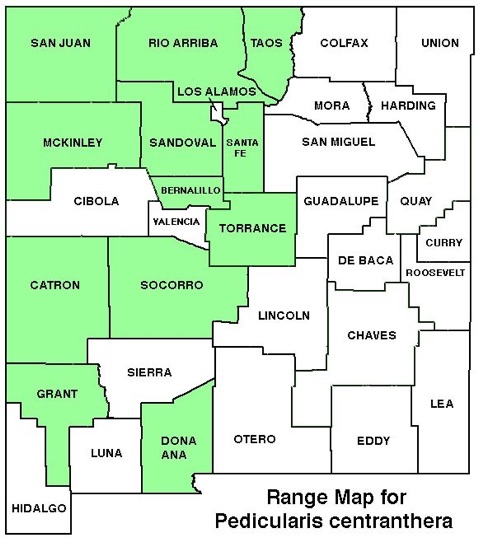WILDFLOWERS OF NEW MEXICO

With a dense cluster of long, deeply-cut leaves, this prostrate plant is easily mistaken for a fern until it sends up a 6-inch-tall stalk with a crowded cluster of tubular, white flowers with pinkish-purple tips. Though able to photosynthesize their own nutrients, louseworts are parasitic on roots of nearby plants.
FLOWERS: March–June. Short spikes 1 1/2–2 3/4-inches tall (4–7 cm) from ground level have a dense cluster of tubular flowers 1 3/8-inches long (35 mm); a curved hood encloses 4 stamens and the lower lip has 3 rounded lobes. The calyx cupping the petals and the faded petals are pinkish-purple.
LEAVES: Alternate on the short stem. Blades linear, 2 3/8–6-inches (6–15 cm) long, with deeply cut fern-like segments with crinkly teeth along a purplish midrib.
HABITAT: Sandy, gravelly soils, open to shaded areas; pinyon-juniper, ponderosa-Douglas fir forests.
ELEVATION: 6,200–10,000 feet.
RANGE: AZ, CO, NM, NV, OR, UT.
SIMILAR SPECIES: 10 louseworts in NM. The prostrate form and hooded, tubular flowers help distinguish this species.
NM COUNTIES: Mountains in western half of NM in mid- to high-elevation, dry habitats: Bernalillo, Catron, Dona Ana, Grant, McKinley, Rio Arriba, San Juan, Santa Fe, Sandoval, Socorro, Taos, Torrance.

DWARF LOUSEWORT
PEDICULARIS CENTRANTHERA
Orobanchaceae, Broomrape Family (formerly in Scrophulariaceae, Snapdragon Family)
Perennial herb

THE CONTENTS OF THIS WEBSITE ARE COPYRIGHTED AND CANNOT BE USED
WITHOUT PERMISSION OF GEORGE OXFORD MILLER







EMAIL ME